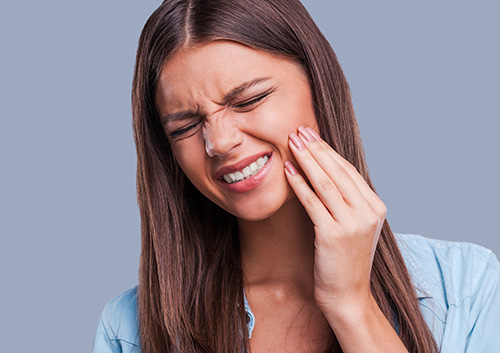I chipped a tooth. What can I do?
December 7th, 2022

You just crunched down on a piece of hard food when you suddenly realize there is something hard still in your mouth. Your nightmare is confirmed when you retrieve a piece of your tooth from your mouth. You chipped your tooth; now what?
Obviously, the first thing you need to do is call our Romeoville, IL office. While we make every effort to see emergent cases immediately, you may have to wait a day or so before you can see Drs. Angela Paros, Amer Atassi, Eric Young, Alexander Katsnelson. Luckily, it’s easy to take care of your chipped tooth while you wait.
How to Take Care of a Chipped
The last thing you want is for the tooth to become infected or break even more. Let’s look at a few things you can do:
- If the chipped tooth is causing you pain take an over-the-counter pain medication, like Tylenol. Always follow the directions on the label.
- You should also rinse your mouth with lukewarm saltwater, as this will help prevent an infection from setting in.
- If your chipped tooth has a sharp edge, cover it up with a piece of wax to prevent it from cutting you cheek, tongue, or lip.
- If you have to eat, make sure you eat soft foods and don’t bite down on the chipped or broken tooth.
Treatment Options for a Chipped Tooth
- Dental Filling and Bonding – If you only have a small chip in your tooth, Drs. Angela Paros, Amer Atassi, Eric Young, Alexander Katsnelson will probably fix it with a filling. If it is a front tooth, we may bond the tooth using a tooth-colored compound.
- Dental Crown or Cap – If you broke a large piece of your tooth, we may grind the remaining part of your tooth and put a crown or cap on it.
- Dental Veneers – If you chipped or broke your front tooth then choosing a dental veneer may be your best choice. It will make your tooth look completely normal.
- Root Canal – If you cracked your tooth and the center (pulp) of the tooth is exposed and infected, you will need a root canal. If the center of your tooth is exposed, it becomes vulnerable to bacteria that will cause your tooth to abscess.
Chipping or breaking your tooth is never a good thing, and you should always call our Romeoville, IL office right away. The sooner you get your tooth repaired the less likely you are to have any problems with it.
How do I clean my baby’s teeth?
November 30th, 2022

Creating good dental hygiene habits early in your child’s life is essential to the health of his or her teeth, even when your infant doesn’t have any. By starting now, you can set the foundation for your son or daughter’s oral health later on in life.
When do I start?
The best time to begin brushing your baby’s teeth is before that first tooth ever comes in. Wipe your little one’s gums gently with a soft washcloth soaked in warm water every day. Not only will this help to get rid of bacteria in the mouth, but it will also familiarize your child with a daily brushing routine.
What do I use?
When your child’s teeth begin to emerge, it’s time to switch to a baby toothbrush. Select one with a big grip for your hand and a small head that’s easy to maneuver in your baby’s mouth.
Your little one won’t need toothpaste until he or she is about a year old; and even then, only a small amount is necessary. Apply an amount the size of a grain of rice and move to a pea-sized amount when your infant is about two years old.
By around six years, your child will probably rinse and spit without your help. At this time, you may introduce a child-friendly fluoride mouthwash.
How do I do it?
Until about age five or six, it’s likely your child will still need your help with brushing teeth. Gently scrub over all the teeth and gums, even where teeth have yet to come in. It may be helpful to explain what you are doing and how you are doing it, so your toddler can learn to brush her or his teeth alone.
Paired with regular visits with Drs. Angela Paros, Amer Atassi, Eric Young, Alexander Katsnelson at our Romeoville, IL office, proper hygiene habits instilled in your child early on will set up a good foundation for a healthy mouth in the future.
Gum Disease vs. Periodontitis
November 23rd, 2022

Many people use the terms gum disease and periodontitis interchangeably, but periodontitis is only one stage of gum disease. The phrase refers to all diseases that affect the gingiva, or gums.
Periodontitis can vary in severity from early to advanced and is often treated by a periodontist — a dentist who specializes in treatment and prevention of gum disease — like Drs. Angela Paros, Amer Atassi, Eric Young, Alexander Katsnelson.
Gum disease begins with inflammation of the gums, but it can progress to cause damage to the soft tissues and bones in the mouth. Bacteria in the mouth that build up to form plaque and tartar cause the inflammation.
Inadequate oral hygiene is usually the culprit of this bacterial build-up, which leads to inflammation — what’s called gingivitis. Gums with gingivitis become red and swollen, bleed easily, and are sometimes painful. Practicing good oral hygiene and getting regular dental exams and cleanings can usually reverse gingivitis.
If left untreated, gingivitis can deteriorate into periodontitis, when the inflamed gums pull away from the teeth. This forms spaces or pockets where bacteria can gather and cause infection.
The body’s immune response and bacterial deposits start to break down the connective tissue and bone that hold teeth in place. This can result in loss of teeth and destruction to the surrounding bones and gums.
The main goal of any treatment for gum disease at our Romeoville, IL office is to control the infection. Treatment varies, depending on the severity, and may include medication and surgery.
So not all gum disease is created equal, but it is all equally easy to prevent. It's best to avoid the problems of gum disease by:
- Brushing twice a day and flossing regularly
- Getting regular cleanings from your dentist or dental hygienist
- Avoiding activities that harm the gums, such as smoking or chewing tobacco
What stinks?
November 16th, 2022

Spilling soda on someone’s white shirt, telling an off-color joke at an inappropriate time, or sneezing chewed food all over the dinner table all pale in comparison to the socially unacceptable, embarrassing blunder of having ... bad breath!
Five Possible Causes of Halitosis
- Poor oral hygiene practices. Failing to brush your teeth encourages anaerobic bacteria growth, which involves a type of bacteria that emits volatile sulfur compounds (gases) responsible for smelly breath.
- If you have tonsils, you may have tonsil stones embedded in the fissures of your tonsils. Tonsil stones are hard, tiny pieces of bacteria, dead oral tissue, and mucus that form inside tonsil crevices. When accidentally chewed, they release extremely foul odors that others can smell and you can actually taste.
- You have a chronically dry mouth due to medications, allergies, or persistent sinus conditions that force you to breathe through your mouth. Anaerobic bacteria thrive in dry, stagnant environments where oxygen content is minimal. Consequently, a dry mouth tends to lead to smelly breath.
- You have acid indigestion or GERD (gastroesophageal reflux disease). If you constantly belch stomach gases, this not only causes your breath to smell fetid but it can lead to enamel erosion and tooth decay.
- You have one or more oral diseases: gingivitis, periodontitis, or infections in the gums known as abscesses.
Improving oral hygiene practices may eliminate bad breath, but if brushing, flossing, and rinsing with a fluoride mouthwash twice a day doesn’t stop people from backing away from you when you open your mouth, it’s time to visit High Point Dental Group.






